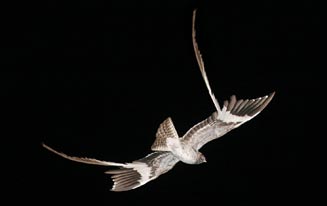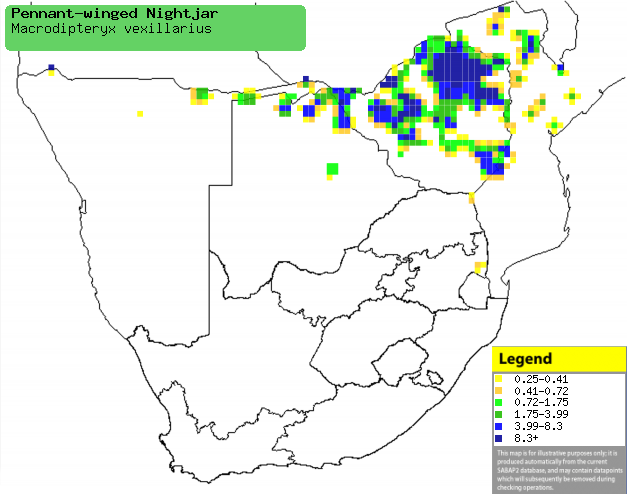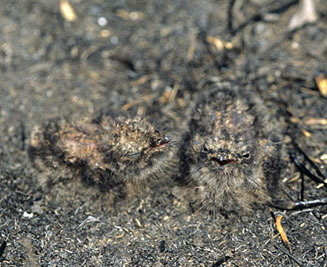|
Macrodipteryx vexillarius
(Pennant-winged nightjar)
[= Macrodipteryx vexillaria]
Wimpelvlerknaguil [Afrikaans]; Wimpelnachtzwaluw [Dutch];
Engoulevent porte-étendard [French]; Ruderflügel [German];
Noitibo-de-balanceiros [Portuguese]
Life
> Eukaryotes >
Opisthokonta
> Metazoa (animals) >
Bilateria >
Deuterostomia > Chordata >
Craniata > Vertebrata (vertebrates) > Gnathostomata (jawed
vertebrates) > Teleostomi (teleost fish) > Osteichthyes (bony fish) > Class:
Sarcopterygii (lobe-finned
fish) > Stegocephalia (terrestrial
vertebrates) > Tetrapoda
(four-legged vertebrates) > Reptiliomorpha > Amniota >
Reptilia (reptiles) >
Romeriida > Diapsida > Archosauromorpha > Archosauria >
Dinosauria
(dinosaurs) > Saurischia > Theropoda (bipedal predatory dinosaurs) >
Coelurosauria > Maniraptora > Aves
(birds) > Order: Strigiformes > Family: Caprimulgidae
 |
 |
 |
|
Pennant-winged nightjar male, Namibia. [photo
Phil Palmer
©] |
Pennant-winged nightjar males, Uganda (note the
different tail sizes). [photo
Pete Morris
©] |
Distribution and habitat
Occurs from Cameroon to Sudan, south through the DRC,
Tanzania, Zambia and Angola to southern Africa. Within southern Africa it is locally common in
the Caprivi Strip (Namibia), northern Botswana, Zimbabwe and
central Mozambique, while scarce in north-eastern South Africa. It generally
prefers mature broad-leaved woodland with plenty of leaf litter, especially if
it has a substratum of sand, stone or burnt ground.
|
 |
|
Distribution of Pennant-winged nightjar in southern Africa,
based on statistical smoothing of the records from first SA Bird Atlas
Project (©
Animal Demography unit, University of
Cape Town; smoothing by Birgit Erni and Francesca Little). Colours range
from dark blue (most common) through to yellow (least common).
See here for the latest distribution
from the SABAP2. |
Predators and parasites
Movements and migrations
Intra-African breeding migrant, breeding in
southern Africa and adjacent countries in the period from
September-February, after which it heads north to its equatorial
non-breeding grounds.
Food
Mainly eats insects, doing most of its foraging over broad
clearings at dusk and just before daybreak, catching prey aerially. The following food items have been recorded
in its diet:
Breeding
- Usually a polygynous solitary nester, with the male performing a spectacular
display in which it flies around to display its long pennants, occasionally
perching to give out a call. Strangely, a group of hundreds was once
recorded in Zimbabwe mass-mating along a 25 km stretch of gravel road.
- The nest is an unlined scrap in the soil, usually shaded by a tall tree.
 |
|
|
Pennant-winged nightjar chicks (camouflaged with
the surrounding soil), Mutinondo, Zambia. [photo
Warwick Tarboton ©] |
|
- Egg-laying season is from September-January, peaking from
October-November.
- It lays 1-2 eggs, which are incubated solely by the female for about
15-18 days; the eggs are readily deserted if the incubating female is
disturbed.
- Little is known about the development and care of the chicks.
Threats
Not threatened.
References
-
Hockey PAR, Dean WRJ and Ryan PG 2005. Roberts
- Birds of southern Africa, VIIth ed. The Trustees of the John Voelcker
Bird Book Fund, Cape Town.
|
